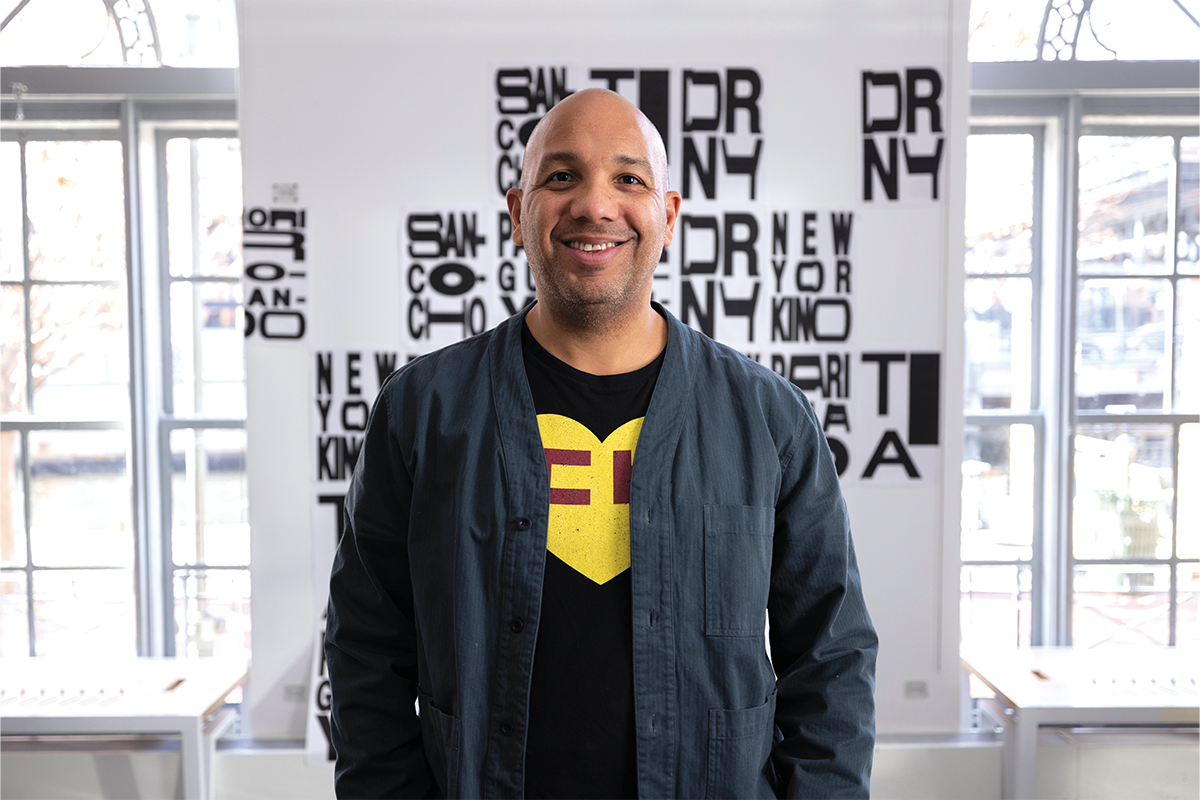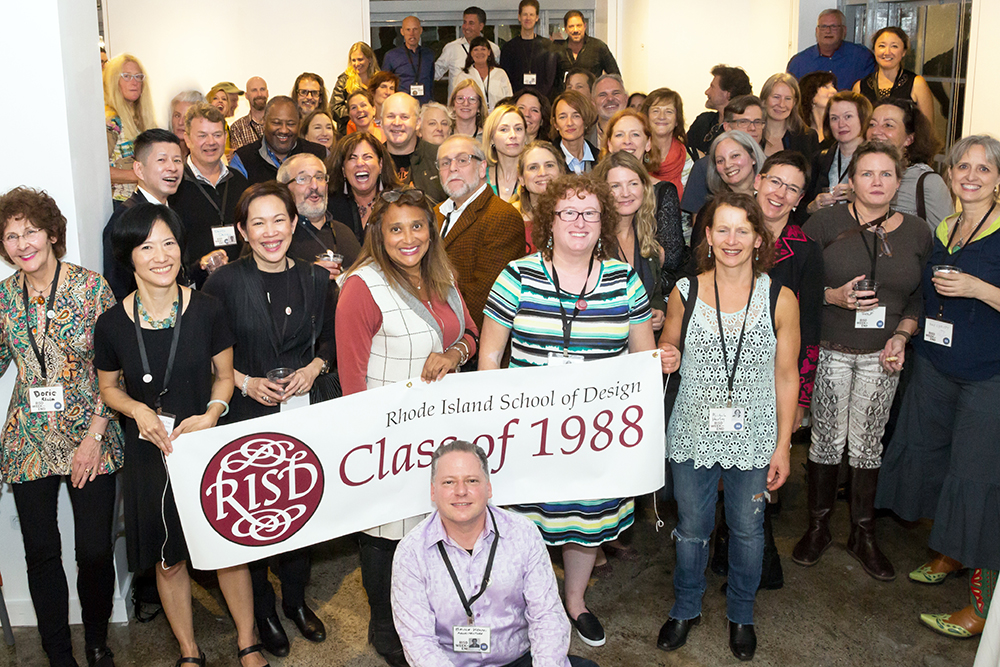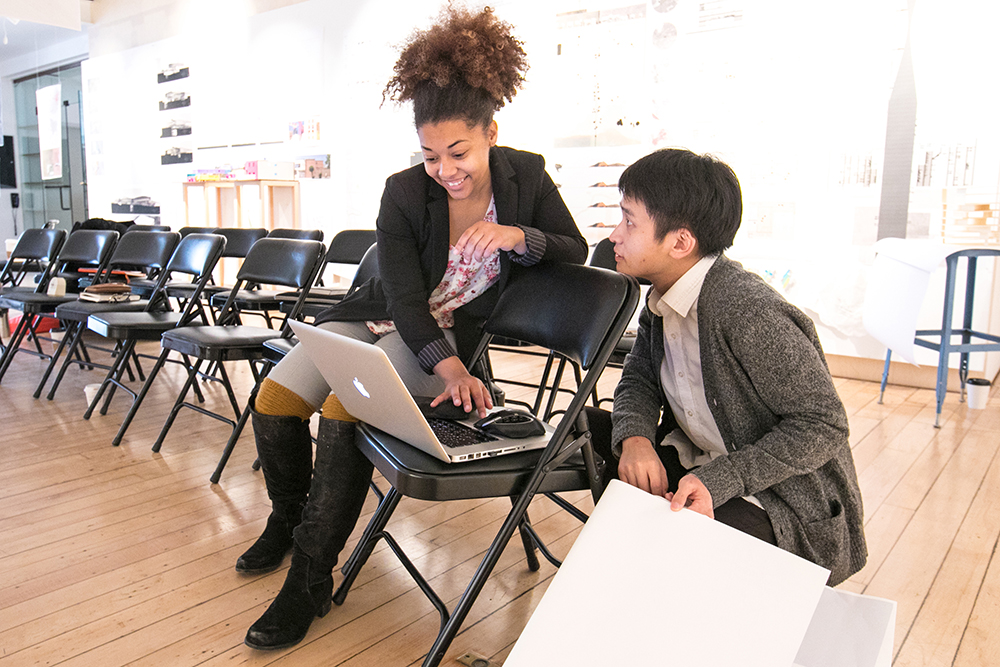
Decolonizing Design
Vilcek Foundation recognizes Ramon Tejada, Wael Morcos and Juan Carlos Noguera.
Every year, the Vilcek Foundation honors foreign-born artists and scientists living in the US who have made outstanding contributions to American society and culture. The New York City–based foundation, estab-lished by Jan and Marica Vilcek, immigrants from the former Czechoslovakia, casts a wide net—past winners in the arts have included cellist Yo-Yo Ma, chef Marcus Samuelsson, author Edwidge Danticat and dancer Mikhail Baryshnikov.
Two Vilcek Prizes for Excellence are awarded each year, one in the biomedical sciences and one in an artistic field. For 2024, design was the chosen arts category and the prize—which carries with it a $100,000 cash award—was awarded to RISD Associate Professor of Graphic Design Ramon Tejada. The foundation also honors emerging to mid-career immigrant professionals with six annual Vilcek Prizes for Creative Promise. Of this year’s three arts recipients, two are RISD alumni: graphic designer Wael Morcos and industrial designer Juan Carlos Noguera.
Ramon Tejada, who was born in the Dominican Republic, was recognized for his commitment to accessibility in design practices. During his own design education, says Tejada, he began to question the accepted canon that forms the baseline in design.
“I think design, for so long, went into this cycle of ‘This is the single way,’” he says, “and to me, there is no single way. Each of us sees things differently.” He encourages his students to think about where they came from and how their home, the neighborhood they grew up in, informs what they make.
In the area of typography, Tejada sees a particular challenge. “Typography, as we talk about it in graphic design, is coming from a completely Eurocentric, Latin-based, Western framework and approach,” he notes. “So if you speak Japanese, Hindi, Farsi or many of the non-Latin-based languages, for example, this Western framework doesn’t work.”
As well as being Eurocentric, “proper” typography frowns on such flourishes as adding strokes to make a letter thicker. “I wanted to add strokes because every street sign I saw growing up in New York City showed that, even though I was told it was wrong,” says Tejada. “Helvetica is the most ubiquitous font in the world and you don’t touch it, you don’t stretch it, you don’t add things to it. Guess what I wanted to do? Make it fatter, make it disappear, blur it away, stretch it. But that’s wrong! Well, in some contexts that’s right. I could tell my students, ‘Don’t do that.’ Or I could say, ‘Traditionally, you don’t do that, but I can show you 50 examples where they did it and it worked beautifully for the context.’”
Ultimately, says Tejada, he wants to make sure his students’ voices are heard and to help them under-stand the value of where they come from. “That is your culture. That is the thing that has been handed down to you. I may not know about it, but I can encourage you to use it as a way to make something that’s valuable for you and your community.”

Wael Morcos MFA 14 GD, a graphic designer who grew up in Beirut, is also engrossed in questions of type. “Typography is very powerful,” says Morcos, whose work with Arabic letterforms has led to the co-creation of more than 10 font families. “At the core, typography and the shape of letters is just a relationship between black and white. But if you zoom out, letters become words, words become sentences, sentences become stories. We are attached to our language more than we know. It anchors us to who we are and what language we speak. Typography is the shape of our language.”
Arabic, notes Morcos, is the third most-used language in the world, spanning all the way from Morocco to Iran, from Syria down to Yemen. “It covers a big part of the globe, which means that it’s also very diverse, with many different nuances,” he says. “There are a lot of different scripts and forms to it, and it’s very malleable, with a rich history, so it’s really a never-ending treasure trove that we can reference and reimagine and bring with us to the digital age.”
As a cofounder, with fellow RISD alum Jon Key 13 GD, of Brooklyn-based design firm Morcos Key, Morcos has developed campaigns for major players such as Nike and IBM, cultural clients including MoMa, and small startups and local schools in New York City, as well as large institutions and museums in the Middle East and Gulf countries.
“Jon is a Black graphic designer from Alabama, and I’m from Lebanon,” says Morcos. “At the beginning, we were curious and apprehensive. What is that going to look like as a partnership? It seemed like there was a lot to unpack that might be too complex for people to approach as clients, but it turned out the exact opposite. Our personal stories permeate the kind of work that we are able to grapple with.”

Apprehension also accompanied Juan Carlos Noguera MID 15 as he made his way in the United States. Noguera had already proven himself as a promising industrial designer in his native Guatemala, working with a team to design durable, repairable wheelchairs that could navigate the local terrain.
Still, arriving at RISD in 2013, he initially felt insecure about his skill level. In time he was able to see that the way he worked could be an advantage because he was used to “not having a ton of re-sources at hand” and often having to find alternate construction methods. “I didn’t have access to materials that are commonplace here in the US,” he says, “so I had to solve things, I had to troubleshoot and say, ‘Yes, we can do it, but in a different way. We can’t just buy our way out of it.’ And that became really useful working in a team setting and with startup companies that have limited capital or resources to solve the problems they run into.”
For Noguera, now an assistant professor of industrial design at Rochester Institute of Technology, early projects that benefited from his resourceful approach included co-designing the world’s first 3D electronics printer, the Voxel8 Developer’s Kit, work that earned him recognition as one of the “35 Innovators Under 35” by MIT Tech Review in 2017.
“Because it was a smaller startup company, I was their entire design team,” says Noguera of the printer project. “So, it was just me as a designer and then 30 engineers that I had to somehow work with and push against and juggle.”
In a spinoff project with the same team, he helped develop the Circuit Scribe educational toy, which helps people understand electronics by drawing a circuit with a pen that holds conductive ink.
As a teacher, Noguera often references his early impostor syndrome to help international students with similar insecurities about doing things differently and trying to fit into the mold of what they think a designer should be. “I’m always trying to tell them that their diverse thinking and experiences are what’s going to make them valuable.”
Lead image: Associate Professor of Graphic Design Ramon Tejada, who works to decoloniize typography and graphic design
Photos: courtesy of the Vilcek Foundation
Words: Judy Hill



